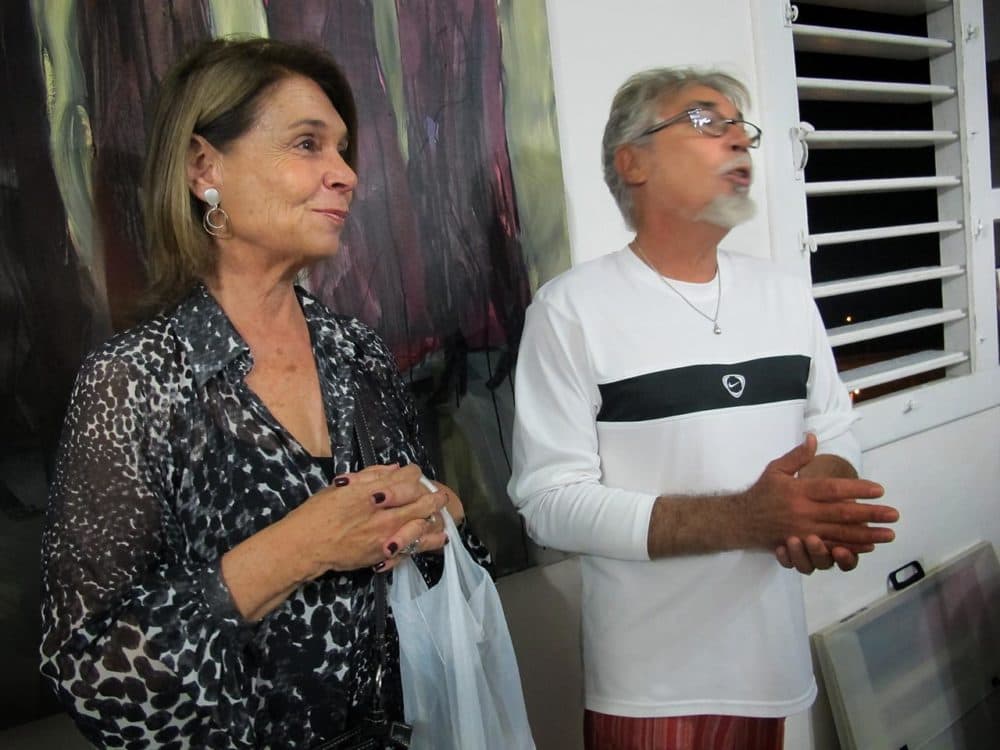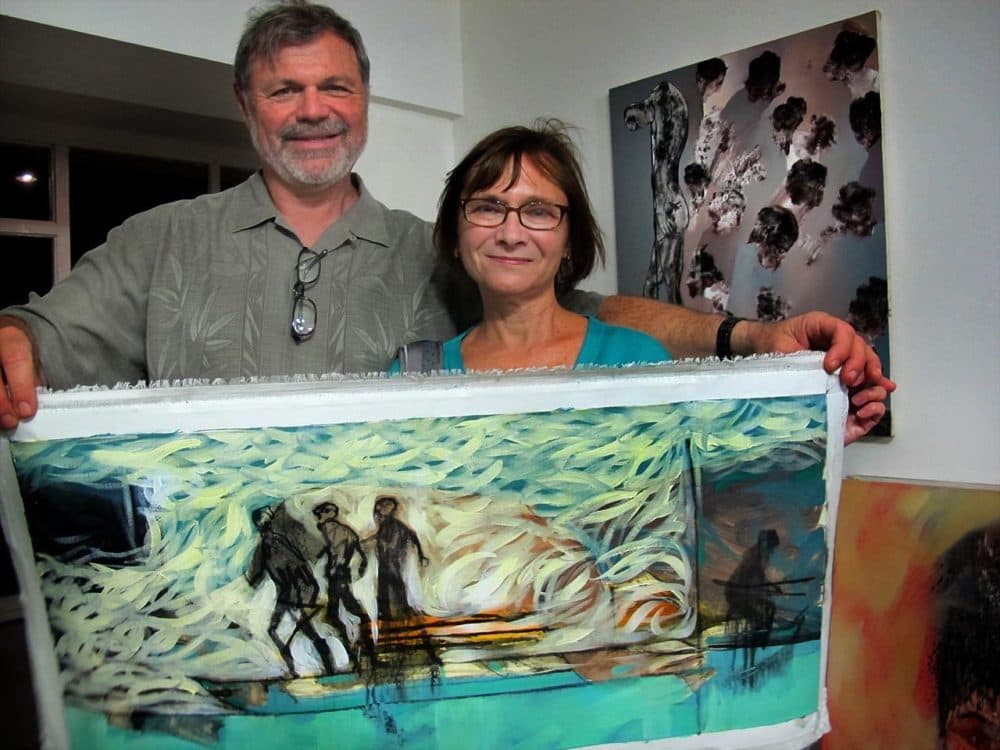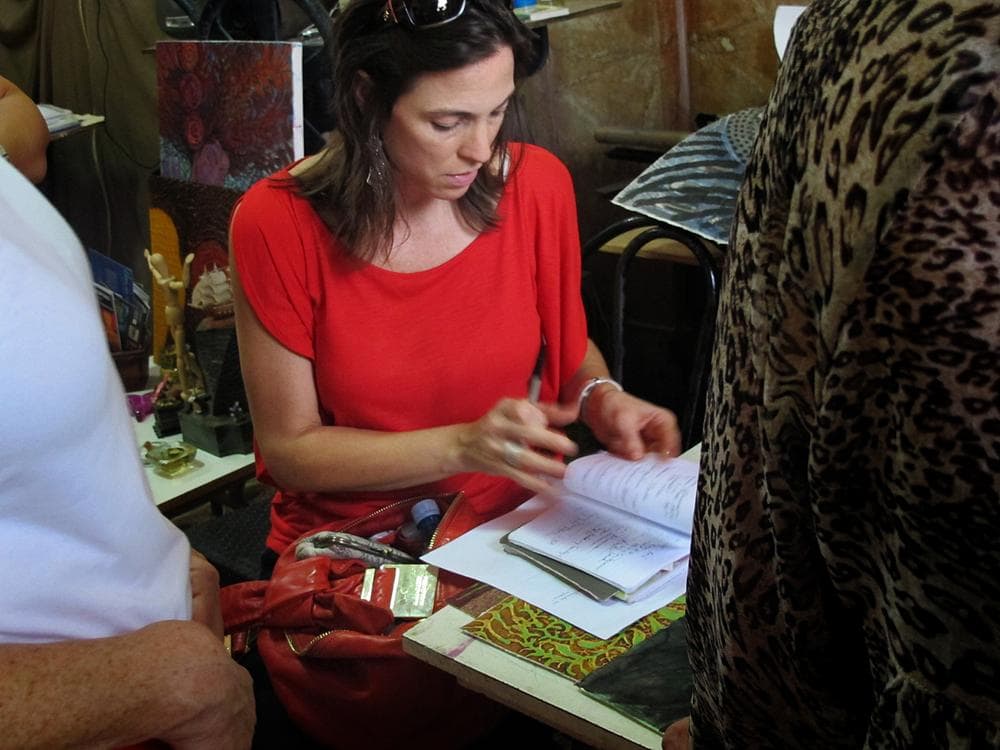Advertisement
Cuba Opens Through Art
Forbidden Fruit: Cuba's Art Scene Flourishes, With A Little Help From Boston
ResumeCuba has fascinated Americans for decades, but the socialist island has been off limits for 50 years because of a U.S. trade embargo.
Things are changing, though. On Monday, the Cuban government ends a pair of long-reviled travel restrictions, making it easier for Cubans to leave their country. And in 2011, President Obama authorized tightly regulated people-to-people cultural tours, allowing more Americans to travel to Cuba.
WBUR's Andrea Shea recently went on one of these trips. Over the next few days we’ll hear her reports, starting with a Boston gallery owner’s "trade mission" to open U.S.-Cuba relations through art.
It’s mind blowing that after a 45-minute flight from Miami you can end up in a whole other world. After navigating airport security, I and 24 other Americans are directed into a big white tourist bus. The reason we’re all in Havana is Michelle Wojcik. She owns Galería Cubana in Boston and Provincetown, and has been running herself ragged getting ready for this trip.
"It's extremely difficult for people to understand Cuba if they've never been here," Wojcik said. "It's really been demonized or exoticized [sic] and it’s quite complex."
Wojcik deals exclusively in Cuban art. She’s traveled to Havana eight times before, always on her own. But this time she’s gone to extraordinary measures to take American art collectors along.
"I just had so many really wonderful clients that have wanted to come to Cuba and when I realized I had the opportunity to do it I just felt I needed to do that," she said.
To make it happen Wojcik teamed up with Silvia Wilhelm, a Miami-based Cuban-American with a U.S. license that allows her to organize people-to-people cultural tours. Those group excursions are one of the few ways Americans can travel to Cuba legally.
This trip’s angle is artistic, but also humanitarian. Wojcik is a social entrepreneur and sees her five-year-old gallery as a “project.” Over five days, she’ll take her clients into artists’ home studios so they can get a glimpse of what it’s really like to live and work in Havana. She also hopes it will deepen their relationships. But the 39-year-old art dealer has another goal: to sell art.
A Cultural Exchange
Our first stop is painter Edel Bordon’s place, not far from the Hotel Nacional.

Bordon lives in an airy, three-bedroom apartment with his two children and wife, sculptor Yamile Pardo. It’s modest by American standards, but palatial for Cuba, where 50 families can share one decrepit mansion.
A bright spread of Cuban food covers a table. Canvases are propped against walls and heaped on the floor. Smiling through a trimmed white beard and wearing a Nike shirt, Bordon welcomes Wojcik’s clients through Wilhelm.
"I know that a lot of you are familiar with my work because of Michelle’s gallery in Boston and Provincetown," Wilhelm translated for Bordon.
The artist is 60 years old and has been painting professionally for 37 years. This is a huge moment for him.
Two of Bordon’s paintings already hang in Steve Zelkowitz and Amy Samuelson’s Wellfleet, Mass., home. Together they own nine works they bought at Wojcik’s Provincetown gallery. With icy mojitos in hand the couple recalls growing up in the 1960s, the aftermath of Fidel Castro’s Revolution, the Bay of Pigs invasion, and when the U.S. trade embargo was first imposed on Cuba.
"There is a surreal feeling about the whole thing, it’s like we’re really in Havana!" Zelkowitz said.
"I mean it’s wonderful to see the artist, it’s wonderful to see his family and have them invite us here," Samuelson added. "It’s great. And it’s Cuba! Who of us would ever have dreamed that we’d be here doing this? I mean never."
It's like taking a bite of forbidden fruit, they say.
Bordon's Art As A Lens Into Cuban Life
One of Bordon's pieces features a dark-skinned woman in a long red dress peering over her shoulder as if she’s being watched. Another shows a man with jet-black hair and a chaotic, Technicolor shirt, his mouth stretched wide into a howl. These images are a lens into Bordon’s view of life on this beautiful, closed, politically fraught island.
Like a lot of Cuban artists he often paints isolated characters, shadowy forms or boats symbolizing freedom and escape. Wojcik says art is one of the only ways Cubans can express themselves.
"Artwork as an outlet for one’s thoughts, one’s feelings, one’s challenges makes for really strong work, and very interesting, very layered, very emotional work," she said.

Zelkowitz and Samuelson hold up a piece they're thinking of buying.
"It’s evocative of a beach scene, which I like," Samuelson explained. "But also some figures that are doing who knows what. They could be nice and good; they could be dastardly people, who knows. Leaves a lot up to the individual in terms of what he or she is getting out of it."
"You know he’s an artist whose work looks dark, who people think would be depressive, but actually quite the opposite," Wojcik added.
Stable Income For Cuban Artists
Wojcik discovered Bordon's work on the Internet in 2007 and they’ve been close friends since. She holds one of about 30 rare licenses issued by the U.S. Treasury that allows her to import Cuban art. A few times a year she flies to Havana, meets with her artists and then carries a trove of their work back to the U.S. At her gallery she stretches the canvases, hangs them and makes the deals.
"The sales really go far. I mean, the money from sales really supports their families," Wojcik said.
Through interpreter Wilhelm, Bordon calls the money a salary.
"It’s a form of income that is stable. But more importantly he is part of a small group of artists that grew with the gallery. So they feel it’s their gallery, it’s his gallery."
Ownership is a new concept to most Cubans. President Raul Castro, brother of retired Cuban leader Fidel Castro, made a limited number of small, independent businesses legal here only two years ago.
But artists have been allowed to engage in private enterprise since the 1990s. American tourists can’t buy Cuban cigars or rum on this trip, but because of an exception to the U.S. trade embargo they can purchase Cuban art. The logistics are complicated, though, and Wojcik’s clients have a lot of questions.

There are two forms of Cuban currency here: a peso for Cubans and CUCs, the currency used by tourists. American debit and credit cards won’t work so you need to bring a lot of cash with you. Wojcik knows how tricky it is to do business here. She juggles a notepad, writing down passport numbers so she can report her clients' sales to Cuba's National Heritage Office.
"You know, in some ways I’m a little nervous about the trip because I’m giving them exposure to the artists directly," Wojcik said. "Which of course, as the middle person, cuts me out somewhat of the picture."
By sacrificing her usual commission Wojcik is serving a larger goal: to improve the lives of Cuban people. From 2001 to 2004 she worked at the World Policy Institute researching the embargo’s economic and social impacts. She says plenty of people reject the idea of Americans doing any kind of business with Castro's Cuba, a country notorious for repressing its people and punishing virtually all forms of political dissent.
"You know there are certainly Cubans that fled Cuba at the time of the revolution that would not be behind this. Most of those people would be in South Florida," Wojcik explained. "I would say in Massachusetts I occasionally get some push back, but it’s not common. And of course this has changed quite a bit over the past 10 years. I think there’s been a little bit of a softening."
Eased Restrictions
Artists like Isolina Limonta have benefited from eased restrictions. She works in the Experimental Graphic Art Studio in Old Havana, a 40-year-old cooperative that's home to Cuba's leading print makers. Poet Pablo Neruda convinced Che Guevara to open to the workshop in the 1960s to save the dying art form.
Limonta creates textured prints on antique presses. The paper she and the other artists use here is thick, expensive and often hard to find because it needs to be imported. American collector Bob Bell has seen Limonta's work at Wojcik's gallery — but now he appreciates it even more.
"I was just thinking as I was walking back to the bus how happy I am to get to see this," Bell said.
Outside the window of the artist’s private studio we can see the roof of a shanty built out of scraps. Someone lives there. It's a striking contrast to the scene inside, where hundreds of dollars in CUCs are being exchanged. Through Wilhelm, the 56-year-old artist says most Cubans, who make about $20 a month, can't afford to buy art so the bulk of her income comes from American sales.
"That’s where she’s been able to make a name for herself because of people like Michelle that have promoted her work in the United States."
'All Problems Can Be Resolved.'
Three of Wojcik’s artists are scheduled to visit the U.S. this year for shows at her galleries, so she needs to bring a lot of their art back to Boston. On the bus she coaches her clients on how to pack their purchases into cardboard tubes she buys at the local craft market, from a man who makes them out of repurposed cylinders.
“I come home penniless. I try to pay people as much as I possibly can.”
Michelle Wojcik, gallery owner
In her hotel room, Wojcik describes what she needs to do before returning to the states.
"I come home penniless," Wojcik said. "I try to pay people as much as I possibly can because it’s so difficult to pay back in the U.S. and figure out how to send money. Typically I return with between 120 to 150 pieces of art."
In the end, Wojcik helped make about $15,000 in sales for her seven artists. She says painter Edel Bordon was able to buy his family a new couch.
"So the days I feel like throwing in the towel at the gallery when I deal with the daily minutiae I have to remember I have several people relying on me in this regard," she said. Wojcik often quotes her Cuban artists, saying, “all problems can be resolved.”
When I ask Bordon how he feels about his work hanging in American homes he replies this way, with a wink, through Wilhelm.
"He says when a beautiful woman buys a painting he says, ‘Please put it in your bedroom,’ so he’s there too!"
More seriously, though, Bordon says he’ll be painting feverishly to get ready for his trip to Boston’s South End in March. He can’t wait to see Wojcik’s clients again at Galería Cubana. And the art dealer has decided to take another group of American art collectors to Havana in February.
"Cuba Opens Through Art" was edited by Martha Little with online editing by Abby Elizabeth Conway, multimedia production by Jesse Costa, and production assistance from Katie Broida. The technical engineers were George Hicks, Missy Webb, Mike Garth, Paul Vaitkus, and JT Trout.
This program aired on January 14, 2013.

